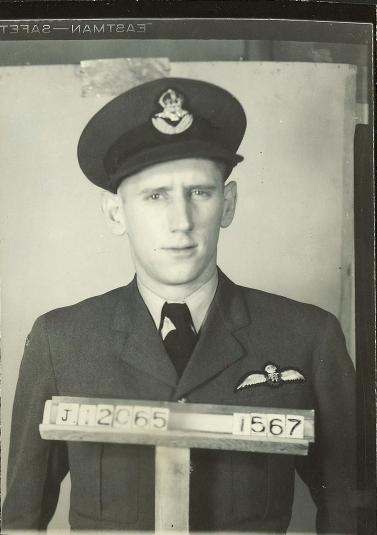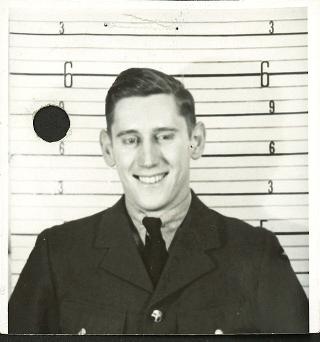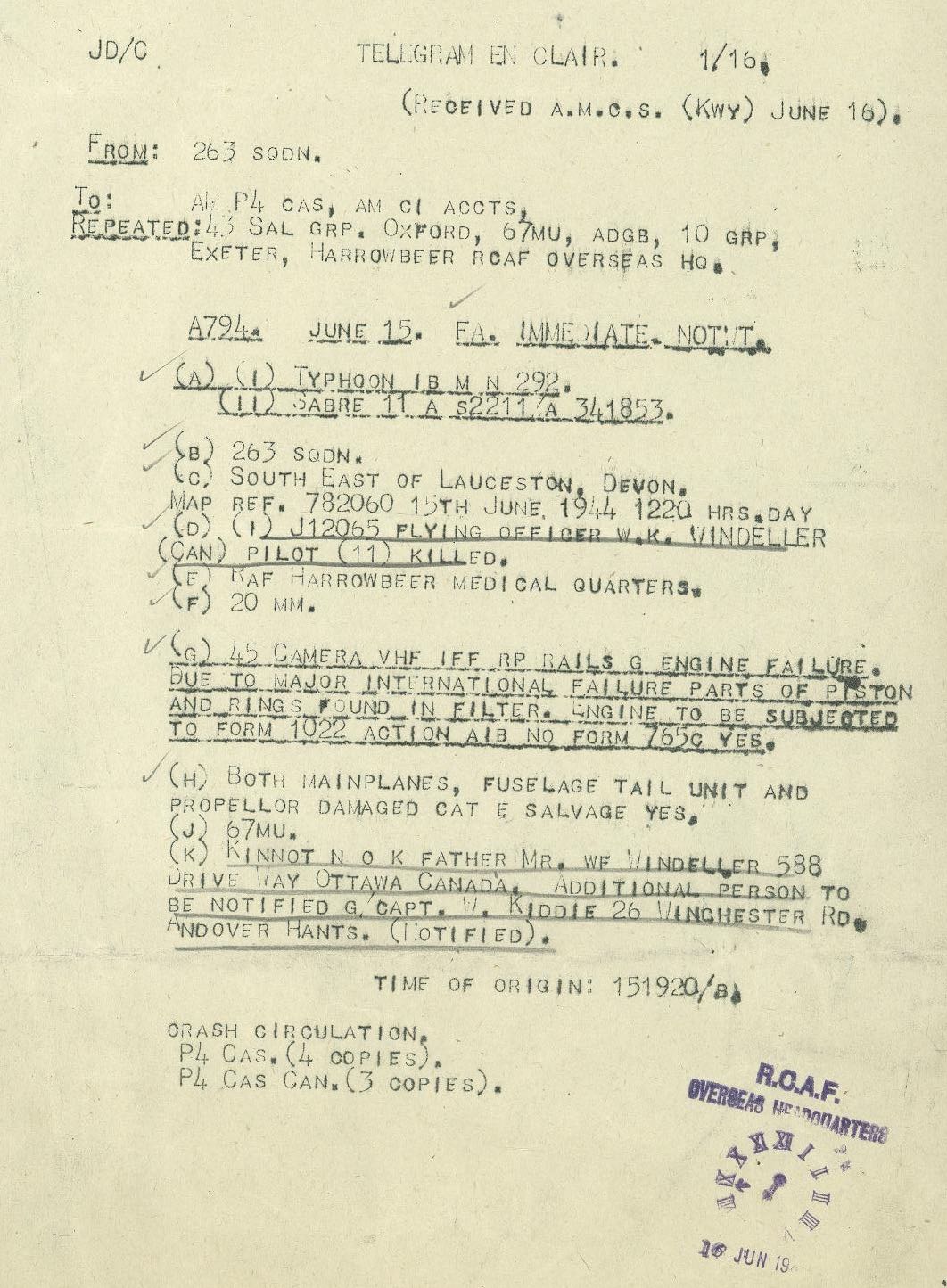


February 19, 1919 - June 15, 1944



William James Windeler was the son of William Frank and Edna Windeler. He had two sisters. The family resided in Ottawa, Ontario and were Anglican. Windeler had been a lab assistant at E. B. Eddy Co. Ltd. prior to enlistment. He stood 6'1" and weighed 170 pounds He had grey eyes and black hair.
He was at No. 1 Manning Depot by August 1941, No. 5 ITS, Belleville, September 1941 ("Very alert and intelligent. Should do well." 88%. 34 out of 150 in the class, No. 13 EFTS, St. Eugene (69.5% flying; Ground Training: 80.9%. "Ability above average. Conduct good. Intelligent. Hard workder. Link Trainer: 82.") "Very slow progress at the start. Became average on flying ability. Keen to fly. If he works hard, he will improve very much." "This student should pay more attention to his airmanship and general flying, especially gliding speeds," "Aerobatics weak. Should improve with practice. Forced landing -- needs improvement in gliding turns; watch gliding speed. Flying is average.), Ontario January 31, 1942, the to No. 2 SFTS Uplands in February 1942 ("Good average pilot, instrument and clear hood -- needs more time on instrument take-offs, aerobatics weak -- forced landings need practice. Link Trainer progress and ability average: 74%'; Ground Training: "Above average ability, keen and efficient. Commission material. Good appearance and bearing. Pilot's preference: Recce, instructor or B."), then to CFS Trenton in June 1942.
In July 1942, at CFS Trenton, he was evaluated: "Average flying ability but needs experience to be competent. He requires flying and instructing experience very badly."
At No. 15 SFTS, Claresholm, Alberta, February 1943: "A capable instructor. Good knowledge of sequence and aircraft. Warrants a raise in category. This officer is a keen and hard working instructor and a reliable pilot."
In March 1943, he was sent to Halifax to go overseas. He arrived at 53 OTU in June 1943 and was sent to RAF Trainees Pool on May 15, 1843. In October 1943: "A confident and capable officer who has carried out his duties to our satisfaction." "Good average at night. An above average pilot. Formates well and has done well on whole course. Reliable and should become a good squadron pilot."
He came down with influenza in early December. On December 4, 1943, Windeler fell in the Officers Mess while off duty and sustained a dislocation of his right elbow. He was treated for one week in collar and cuff inside his clothes. He was advised to continue 'gentle active mobilisation in which he was carefully instructed and to carry limb, apart from exercise, in a sling." By February 7, 1944, he was assessed with a very powerful control of movements, as he had been exercising his elbow properly! He did complain about his range improving very slowly.
On February 19, 1944, Windeler was involved in an accident at 1430 hours, flying Spitfire P.8652. No blame was assigned to the pilot during this training flight at Kirton airfield. The induction trunk was found to be extensively scorched. The port cylinder block was removed and the head of number three cylinder inlet valve was found to be broken. White smoke had issued from both exhausts and the engine died completely. He made a belly landing.
On March 9, 1944, Windeler was involved in another accident at Kirton Lindsey, Lincolnshire flying Spitfire P.7388. Windeler reported, "I had finished my exercise and was about to land. I come in on a normal Spitfire approach at 100 mph. As I straightened out over the hedge, the aircraft seemed to stall prematurely at 95 mph. I rammed open the throttle, but was unable to prevent the wheels from hitting the ground. The impact knocked back my left oleo leg. By this time, I had managed to get the aircraft airborne again. I was instructed by Flying Control to keep airborne, but as I did my second circuit, the aircraft overheated owing to the leg hanging down, and I had to make a belly landing on the airfield." The court of inquiry found that Windeler did NOT make a normal Spitfire approach as he had stated in his report. He came in doing a steep gliding turn with the result that he flew straight into the ground, tearing off the port oleo leg. He was assessed as being careless combined with the lack of skill and it was recommended his log book receive an endorsement.
On June 15, 1944, flying Typhoon 1B MN292, Windeler was was authorized for an air test and local flying, southeast of Lauceston, Devonshire, England, the object of the test being to ensure that the undercarriage up lights were not flickering as reported on a previous flight. After Windeler had been airborne for eighteen minutes, the pilot informed Flying Control that his engine was failing, that he was a fair way from base and would have to set down. Althought the field was the largest in the area, Windeler landed in a field with an earthen bank and several large trees as its windward boundary. The court of inquiry felt that the pilot pushed the nose down at the last moment, as that portion of the aircraft was the first to hit the ground and it went straight onto its back. Windeler died in this fatal forced landing. He was crushed in the cockpit. The findings were such that Windeler had insufficient height to bale out and he had no alternative but to attempt a forced landing. Error of judgement on Windeler's part was also assessed. There were no witnesses to say whether the pilot stalled at the last moment or deliberately put the aircraft nose down to touch down as far as possible from obstacles at the other end of the field.
Windeler's funeral took place at noon on June 19, 1944 in the Brookwood Cemetery, Woking, Surrey, England.
LINKS: